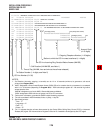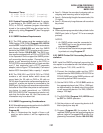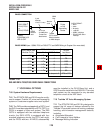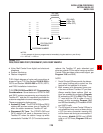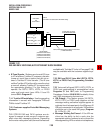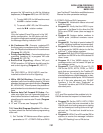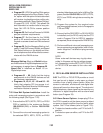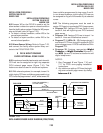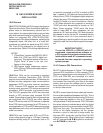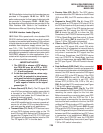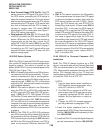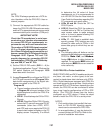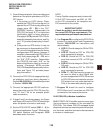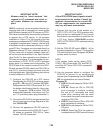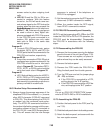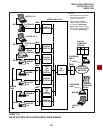INSTALLATION-PERIPHERALS
SECTION 100-816-207
MARCH 1993
7-34
10 DATA INTERFACE UNIT
INSTALLATION
10.00 General
10.01 STRATA DK8 and DK16 support two types of
Data Interface Units (DIUs) that enable digital tele-
phone users to simultaneously transmit and re-
ceive data on the same digital station port and wire
pair while communicating on a voice call. One unit,
called the integrated DIU (PDIU-DI/PDIU-DI2),
becomes part of the digital telephone, replacing the
telephone’s base; the other unit, is a small self-
contained unit called the stand-alone DIU (PDIU-
DS). Each DIU is powered by the digital port it is
connected (see Table 8-D for wiring requirements).
NOTES:
1. “Digital Ports” includes the DK8 KSU, DK16
Base Unit, PDKU and KCDU digital sta-
tion ports. This applies wherever the term
“Digital Ports” is used in the text and
figures in this chapter.
2. 2000-series digital telephones require
PDIU-DI2 and 1000-series telephones re-
quire PDIU-DI.
10.02 Both DIUs can be connected to standard
Electronic Industries Association (EIA) RS-232
asynchronous serial data devices. EIA devices are
divided into two categories: data communication
equipment (DCE) and data terminal equipment
(DTE). Common DCE devices are modems and
some printers; common DTE devices are personal
computers, ASCII terminals, and some printers.
The PDIU-DI operates like a DCE and connects
directly to DTE devices using standard RS-232
cables. Depending on how its internal jumper plugs
are configured, the PDIU-DS can either operate
like a DTE and connect to DCE devices; or operate
like a DCE device and connect to a DTE device. In
most applications, DTE and DCE devices exchange
data between each other via the standard RS-232
cable connection.
10.03 DIUs can function with DCE and DTE de-
vices at data speeds of up to 19.2 kbps. However,
keyboard dialing using AT commands (from a PC
or terminal connected to a DIU) is limited to 9600
bps. A speed of 19.2 kbps can be achieved when
dialing from a PDIU-DI-equipped digital telephone
dialpad, but many PC software programs do not yet
handle 19.2 kbps in an error-free manner. Also for
a 19.2 Kbps operation the computer or terminal’s
“COM” port must be specified to function at 19.2
Kbps. Some computer “COM” ports, like those
used in older IBM XT type computers, will not
operate at 19.2 without errors. DIU data transmis-
sion speed is set by the first AT command that the
DIU receives once it is in the command state; if
manual dialing or receiving calls in the auto answer
(default) mode, the transmission speed is transpar-
ent.
IMPORTANT NOTE!
To use the PDIU-DI or PDIU-DS with AT
commands, communications software or
a PC program that performs terminal emu-
lation must be used. AT commands cannot
be issued from the computer’s operating
system prompt.
10.10 Common DIU Connections
10.11 The block diagram in Figure 7-24 illustrates
common DIU connections. In this example, PDIU-
DIs are connected to personal computers (PC1 and
PC2), and PDIU-DSs are connected to a serial
printer and modems. The personal computer users
can transfer files internally, print files on the same
printer, and access the modem pool to send/re-
ceive data to/from an external personal computer
or dial up data service.
10.12 To access these devices, a data call connec-
tion must be established between the DIUs. This is
accomplished by dialing the destination DIU from a
digital telephone dialpad or from a PC keyboard
using standard AT dial commands. PDIU-DIs share
the same intercom numbers/ports with the digital
telephone to which they are connected, while PDIU-
DSs have their own. The Intercom and Data Call
LEDs on the digital telephone tell the system
whether a voice or data call is being made: the
Intercom LED, voice calls; and the Data Call LED
initiates data calls. When dialing from a keyboard
with AT commands, A␣ T D is typed for voice calls,
and A T D D for data calls.



